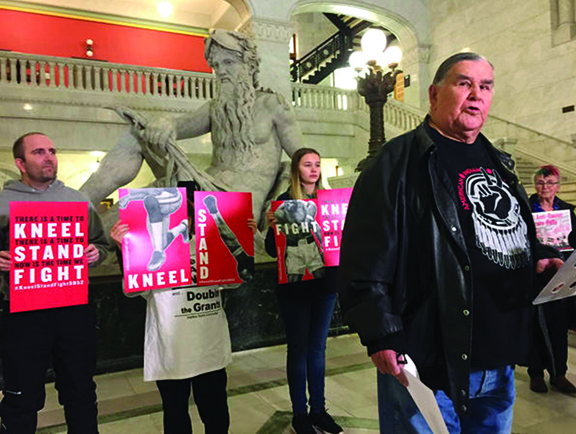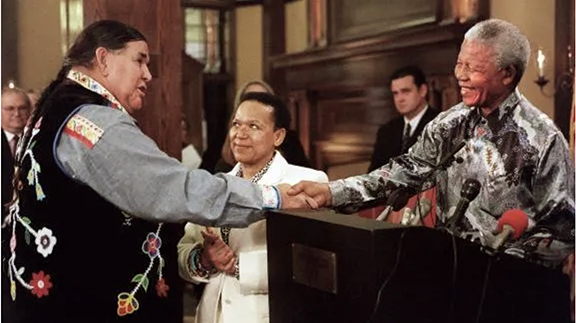
By Lee Egerstrom
Native Americans across North America and indigenous people worldwide have been paying tribute and recalling memories of Clyde Howard Bellecourt, 85, who died at his home in Minneapolis on Jan. 11.
As a co-founder of the American Indian Movement (AIM), Bellecourt was a leading influencer of Native American and indigenous people’s efforts to overcome discrimination, seek justice, and overturn disrespectful stereotype images and portrayals of Native people.
AIM was organized in Minneapolis in 1968 by Bellecourt, Dennis Banks, Eddie Benton-Banai, George Mitchell and others. For most of the past five decades, it has served as an incubator for starting educational, social justice, legal justice and women’s health and safety organizations.
“Uncle Clyde knew seeking civil rights and respect are never completed, never ending tasks for our organizations,” said Lisa Bellanger, AIM executive director, using an honorific for Bellecourt that is a common title of respect within the movement.
A case in point was Bellecourt’s long effort to replace and eliminate disrespectful images and names for athletic teams. In this case, Bellecourt’s Ojibwe name Nee-gon-we-way-we-dun, or “Thunder Before the Storm,” was especially fitting.
When this writer was a Washington correspondent for Ridder Publications and Knight Ridder Newspapers in the 1970s, Bellecourt organized a press conference at the National Press Club to stress how hateful and disrespectful the Washington professional football team’s name (Redskins) was to Native people.

It may have been the only time a press conference was called for the purpose of educating news media professionals, knowing full well that what was said would not be printed or broadcast anywhere in the country.
“When Washington plays the New York (derogatory religious slur), we always cheer for the (deleted slur). When Washington plays Philadelphia (ethnic slur), we cheer for (the deleted slur).”
Bellecourt shocked reporters by touring around the National Football Conference, coining horrible ethnic, racial and sexual orientation slur names for all the major teams with the exception of the Minnesota Vikings.
A reporter for the Cleveland Plain Dealer sat next to me. He nudged me at one point and said it was a shame none of us would write this story – then in the mid-1970s. Today, social media, mostly immune to common decency, would instantly send that message out across the country.
A little later as Bellecourt continued to drive home his points about disrespectful athletic imagery, my friend from Cleveland nudged me again. “Chief Wahoo has got to go,” he said.
That latter cartoon caricature was the Cleveland Indians baseball team mascot, not for football, and was another target of AIM and related Native organizations’ image cleansing efforts.
It has been more than a four-decade struggle, but here is what has happened:
When Cleveland’s professional baseball team takes the field to start the 2022 season this spring, it will be known as the Cleveland Guardians. The name Cleveland Indians is gone. The racist caricature Chief Wahoo was phased out three years ago. In recent years, baseball uniforms have substituted a stylish “C” for Cleveland in place of the mascot.
Meanwhile, on Feb. 2, the Washington Football Team is scheduled to reveal a new team name to replace Redskins – the offensive, scalp-inspired name that was finally shelved the past two seasons.
The team spent 18 months on research since retiring the name in July 2020. Fan surveys, focus groups and related legal investigations came up with a list of possible finalists that include Armada, Presidents, Brigade, Red Hogs, Commanders, Red Wolves, Defenders and continued use of Washington Football Team.
The team has told Washington media that a name chosen will not reference Native Americans or the Red Wolves name, and that the team colors will retain the long standing burgundy and gold.
This follows decades of protesting teams using Indian mascots and even schools named after people who are historically offensive to Native communities. While much has been accomplished, this work continues, said AIM’s Bellanger.

Bellecourt was front and center at highly visible protests that included the 1991 World Series between the Atlanta Braves and Minnesota Twins, and Washington’s Super Bowl game in Minneapolis when it play the Buffalo Bills.
Tied in with those actions, AIM and groups formed the National Coalition on Racism in Sports and Media in 1991 at a conference at Augsburg College.
This all fits the educational objectives of AIM and Native American leaders, Bellanger said. That reflects how such efforts spill over to form new, clearly focused groups to work on public awareness and public policy.
Bellecourt and AIM leaders, including brother Vernon Bellecourt (1936-2007), were instrumental in starting “survival schools” in the Twin Cities that was replicated in other urban communities nationwide. These schools have linked with urban school districts, become part of the system and continue to provide various tribal and cultural educations in the schools.
Bellanger herself is a teacher and an Indian Education Program specialist for St. Paul Public Schools.
A spillover on this education front was creation of the American Indian Opportunities Industrialization Center (AIOIC) alternative school and career training program in Minneapolis. It dates back to 1979. Bellecourt is considered a founder and served on AIOIC’s board of directors until his death.
Another derivative of this educational focus is MIGIZI, founded in 1977 as MIGIZI Communications in the large Native neighborhood area of south Minneapolis. It is a nonprofit that encourages that encourages Native student academic achievement and Native profiles and narratives in media presentations.
Its first president and co-founder was Laura Waterman Wittstock who was also an AIM historian.
From protest to protest, and project to project, Bellecourt and AIM did trigger the Native community and its allies to take action that includes starting groups to continue work on Indian legal rights, sovereignty issues, health care and safety, and issues specific to women, Bellanger said. It also included working with Black and other groups with shared concerns, such as starting the Legal Rights Center as a community owned law firm in Minneapolis
“We know our work will never be done,” she said.
That was stressed in comments from Gov. Tim Walz and Lt. Gov. Peggy Flanagan issued after Bellecourt’s death was announced. While AIM works nationally and, with others, internationally, much of what Bellecourt and AIM started began and continues on in Minneapolis and Minnesota.
Flanagan, also a White Earth Nation member, noted that. “Minneapolis has one of the most robust and vibrant networks of organizations serving the urban Indian community, and that is because of Clyde and his work,” Flanagan said.
Family and friends said their goodbyes within a traditional time frame, with fire, Bellanger said. A community memorial is also being planned for later, possibly on or around Bellecourt’s birthday.
Clyde Howard Bellecourt (May 8, 1936 – Jan. 11, 2022) was born at the White Earth Nation but primarily lived in Minneapolis over the years. He is survived by his wife, Peggy; sons Wolf and Little Crow, of Minneapolis; daughters Susan, of Redwood Falls, and Tanya, of Minneapolis; plus nine grandchildren and eight great-grandchildren.
Published obituaries focusing on much of Bellecourt’s life and works include: https://www.npr.org/2022/01/12/1072435745/clyde-bellecourt-american-indian-movement-dies-obituary,
https://www.mprnews.org/story/2022/01/11/longtime-native-activist-leader-clyde-bellecourt-dies-at-85
A concise history of AIM (A Brief History of the American Indian Movement, by Laura Waterman Wittstock and Elaine J. Salinas), is at https://www.aimovement.org/ggc/history.html.






